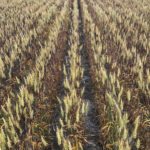
Features

Manitoba soybeans not responding to K?
Soybean potassium fertility trials leave researchers scratching their heads

Don’t forget lessons of the Dirty 30s
Although there’s a perception that dust is past, tillage erosion is on the rise in Manitoba

High-tech and higher-level training
Moving your farm to high-tech solutions doesn’t mean safety can take a backseat

AAFC projects focus on aphanomyces root rot in pulse crops
Good management practices still the best way to control aphanomyces in the field

New phosphorus research for canola on the way
Canola removes more phosphorus from the ground than the recommended safe rate
Mental health is a farm safety issue
Farming is stressful, for farmers and their families. Make mental health a priority
’Tis the season for farm safety
The busiest times of the year are also the best times to slow down and plan for safety

Crop advisor casebook: What’s causing extreme stem discolouration in this wheat crop?
A Crop Advisor's Solution from the March 13, 2018 issue of Grainews

72 hours or more…
Farm Safety Week: Canadians are advised to be prepared for 72 hours without services. Are you ready?

In-crop mechanical weed control
Controlling weeds mechanically can help overcome Group 2 resistant weeds in pulses


